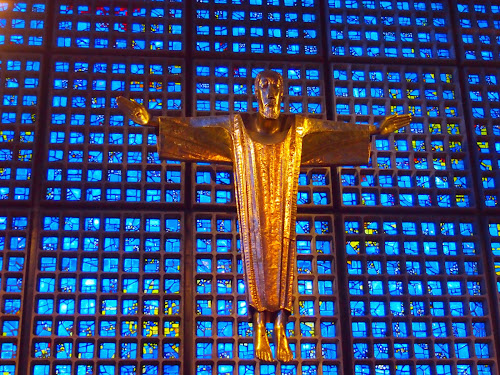We started our day at Kaiser Wilhelm Memorial Church, originally consecrated in 1895 and named by Kaiser Wilhelm II in honor of his grandfather. It was irreparably damaged in a bombing raid in WWII and a modern church has been constructed in four buildings clustered around the ruins. The 1963 construction is undergoing renovation. The figure of Jesus is made of tombak, a metal with which we hadn’t been familiar.
We next visited one of 16 atomic bomb shelters constructed in Berlin in the 1970s. It was intended to house 3600 people for two weeks and there were rooms designed to count people through peepholes so that no more than the allotted number could enter the shelter itself. It would have been insanely cramped and claustrophobic if ever used, not to mention that the 16 shelters would only have housed 1% of Berlin’s population. There were no mirrors so as to discourage suicide and deprive the berserk of potential weapons. The kitchen in the photo would serve 1800 people. Two of the four well water pumps were left as manually operated ones to provide the opportunity for exercise or to vent pent up anger.
After a civilized lunch, a visit to the Kathe Kollwitz museum and some shoes-off time at the hotel, we returned to the Memorial to the Murdered Jews of Europe, an evocative city block near the Brandburg Gate. Our first evening we walked through in the dark. The terrain undulates across the field, so that the blocks vary greatly in height to maintain only slight variations on the visual surface. Jewish people had been deeply woven into the life of Berlin for centuries. Perhaps 10,000 live there now.
For our final dinner in Berlin, we went for sausages – good ones. We were encouraged by the warm smell of a wood fire and sausages being grilled. We weren’t disappointed.
We also returned to the Brandenburg Gate to check out the festivities marking the 25th anniversary of the fall of the Berlin Wall. The balloons lined 10 miles out of the more than 25 miles of death strip that once kept East Germans out of the west. Tonight it was the scene of a party with balloons marking the path of the Wall.
All along the path of the wall, large screens played out scenes from the time when the wall separated families and destinies: scenes like an East German official saying, “If people don’t respect our borders, they will taste our bullets” and footage showing the wide “no man’s land” on the east side of the wall laced with barbed wire and guards on both sides lobbing tear gas canisters at each other.

















